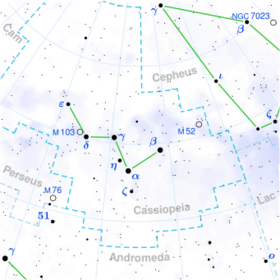Astronomy:2 Cassiopeiae
| Observation data Equinox J2000.0]] (ICRS) | |
|---|---|
| Constellation | Cassiopeia |
| Right ascension | 23h 09m 44.1389s[1] |
| Declination | +59° 19′ 57.687″[1] |
| Apparent magnitude (V) | +5.679[2] |
| Characteristics | |
| Spectral type | A4II[3] (kA5hA7mF0)[4] |
| U−B color index | +0.31[5] |
| B−V color index | +0.33[5] |
| Astrometry | |
| Radial velocity (Rv) | −13.58±0.15[1] km/s |
| Proper motion (μ) | RA: +0.335[1] mas/yr Dec.: +0.552[1] mas/yr |
| Parallax (π) | 1.1900 ± 0.0386[1] mas |
| Distance | 2,740 ± 90 ly (840 ± 30 pc) |
| Absolute magnitude (MV) | −2.92[6] |
| Details | |
| Mass | 5.3[7] M☉ |
| Radius | 41[8] R☉ |
| Luminosity | 3,014[8] L☉ |
| Surface gravity (log g) | 1.93[7] cgs |
| Temperature | 8,012[9] K |
| Metallicity [Fe/H] | −0.23[7] dex |
| Rotational velocity (v sin i) | 5.3[10] km/s |
| Other designations | |
| Database references | |
| SIMBAD | data |
2 Cassiopeiae (2 Cas) is a white bright giant in the constellation Cassiopeia, about 2,800 light years away. It is a chemically peculiar Am star.
2 Cassiopeiae has been described as an A4 type bright giant, buts its spectrum is not easy to classify. The calcium K absorption lines indicate a hotter type than the hydrogen lines, while other metals indicate a cooler type, possibly as cool as F0. This makes it an Am star, a type of magnetic chemically peculiar star with unusual abundances showing in its spectrum due to chemical stratification in its atmosphere caused by slow rotation.[5]
About six times as massive as the Sun and 3,000 times as luminous, it has expanded away from the main sequence after exhausting its core hydrogen and now has an effective temperature of about 8,000 K. Some researchers have suggested that it is a post-AGB star.[3]
2 Cassiopeiae has a number of close companions listed in multiple star catalogues,[11] but none are thought to be gravitationally associated.[12]
References
- ↑ 1.0 1.1 1.2 1.3 1.4 1.5 Vallenari, A. et al. (2022). "Gaia Data Release 3. Summary of the content and survey properties". Astronomy & Astrophysics. doi:10.1051/0004-6361/202243940 Gaia DR3 record for this source at VizieR.
- ↑ Høg, E.; Fabricius, C.; Makarov, V. V.; Urban, S.; Corbin, T.; Wycoff, G.; Bastian, U.; Schwekendiek, P. et al. (2000). "The Tycho-2 catalogue of the 2.5 million brightest stars". Astronomy and Astrophysics 355: L27. doi:10.1888/0333750888/2862. Bibcode: 2000A&A...355L..27H.
- ↑ 3.0 3.1 Gray, R. O.; Napier, M. G.; Winkler, L. I. (2001). "The Physical Basis of Luminosity Classification in the Late A-, F-, and Early G-Type Stars. I. Precise Spectral Types for 372 Stars". The Astronomical Journal 121 (4): 2148. doi:10.1086/319956. Bibcode: 2001AJ....121.2148G.
- ↑ Abt, Helmut A.; Morrell, Nidia I. (1995). "The Relation between Rotational Velocities and Spectral Peculiarities among A-Type Stars". Astrophysical Journal Supplement 99: 135. doi:10.1086/192182. Bibcode: 1995ApJS...99..135A.
- ↑ 5.0 5.1 5.2 Renson, P.; Manfroid, J. (May 2009). "Catalogue of Ap, HgMn and Am stars". Astronomy and Astrophysics 498 (3): 961–966. doi:10.1051/0004-6361/200810788. Bibcode: 2009A&A...498..961R.
- ↑ Anderson, E.; Francis, Ch. (May 2012). "XHIP: An extended hipparcos compilation". Astronomy Letters 38 (5): 331–346. doi:10.1134/S1063773712050015. ISSN 1063-7737. Bibcode: 2012AstL...38..331A.
- ↑ 7.0 7.1 7.2 Anders, F.; Khalatyan, A.; Chiappini, C.; Queiroz, A. B.; Santiago, B. X.; Jordi, C.; Girardi, L.; Brown, A. G. A. et al. (2019). "Photo-astrometric distances, extinctions, and astrophysical parameters for Gaia DR2 stars brighter than G = 18". Astronomy and Astrophysics 628: A94. doi:10.1051/0004-6361/201935765. Bibcode: 2019A&A...628A..94A.
- ↑ 8.0 8.1 Brown, A. G. A. (August 2018). "Gaia Data Release 2: Summary of the contents and survey properties". Astronomy & Astrophysics 616: A1. doi:10.1051/0004-6361/201833051. Bibcode: 2018A&A...616A...1G. Gaia DR2 record for this source at VizieR.
- ↑ Stassun, Keivan G. et al. (2019-10-01). "The Revised TESS Input Catalog and Candidate Target List". The Astronomical Journal 158 (4): 138. doi:10.3847/1538-3881/ab3467. ISSN 0004-6256. Bibcode: 2019AJ....158..138S.
- ↑ Schröder, C.; Reiners, Ansgar; Schmitt, Jürgen H. M. M. (January 2009). "Ca II HK emission in rapidly rotating stars. Evidence for an onset of the solar-type dynamo". Astronomy and Astrophysics 493 (3): 1099–1107. doi:10.1051/0004-6361:200810377. Bibcode: 2009A&A...493.1099S.
- ↑ Mason, Brian D. et al. (December 2001). "The 2001 US Naval Observatory Double Star CD-ROM. I. The Washington Double Star Catalog". The Astronomical Journal 122 (6): 3466–3471. doi:10.1086/323920. Bibcode: 2001AJ....122.3466M.
- ↑ Eggleton, P. P.; Tokovinin, A. A. (3 September 2008). "A catalogue of multiplicity among bright stellar systems". Monthly Notices of the Royal Astronomical Society 389 (2): 869–879. doi:10.1111/j.1365-2966.2008.13596.x. Bibcode: 2008MNRAS.389..869E.
 |


